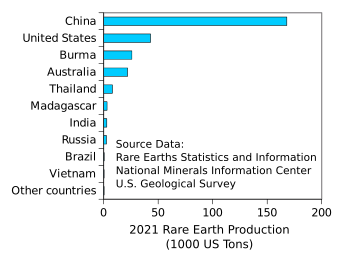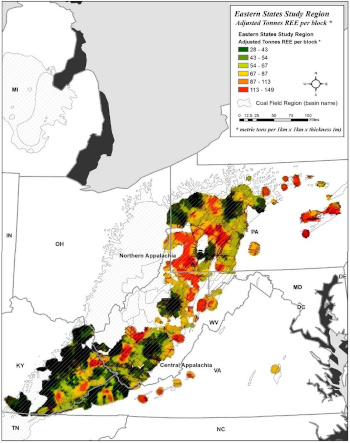Rare Earths from Coal Waste
April 18, 2022
The
rare earth elements were the focus of my early
research career. The research topics were
permanent magnets,
hydrogen storage materials,
magnetic bubble memory materials,
phosphors, and
solid state lasers. In today's world, you can find rare earths in permanent magnets, in
motors and
actuators, especially those for
automobile applications such as
window openers,
windshield wipers, and
door locks, in
headphones and
earpieces, and in
position actuators for
computer hard drive read-write heads. The rare earth elements are also important as additions to
catalysts. I've worked with every one of the rare earth elements, except for the
unstable element Promethium (61Pm).
These
elements are called
rare since they exist in very low
concentrations in
Earth's crust and this leads to high
prices. For example, the current price of neodymium
metal, an important component of permanent magnets, is about $65,000 per
US ton, as compared with the price of
iron, $425/US ton. In most cases, this is a consequence of the fact that elements of high
atomic number are
less abundant in the universe than those of low atomic number. The distribution of these elements among
countries is not
uniform. As the following
chart shows,
China is the major producer of rare earths, a fact that is problematic for other countries, and there have been efforts to extract rare earths from unusual sources, such as the
seafloor.[1]

Rare earth production by country in 2021.
China produced 168,000 US tons of rare earth oxide equivalent in 2021, up from 140,000 the previous year.
(Chart created using Gnumeric from data in ref. 2.[2] Click for larger image.)
Coal has been used extensively as an
energy source, and one consequence of that usage is the enormous amount of
ash produced by coal
combustion (see table). Coal ash contains mostly
silica (silicon dioxide, SiO
2, 20-40 wt-%),
aluminum oxide (Al
2O
3, 10-35 wt-%),
iron oxide (Fe
2O
3, 5-35 wt-%), and
calcium oxide (CaO, 1-20 wt-%), along with smaller quantities of the
toxic elements,
mercury (Hg, 0.10 ppm),
arsenic (As, 1.4–71 ppm), and
selenium (Se, 3 ppm). Coal ash also contains rare earths, particularly scandium and neodymium, in concentrations up to 100 times higher than the concentration in Earth's crust.
To quantify the potential for rare earth recovery from coal, we need to examine how much coal is produced annually, even under the threat of
global warming. The following table lists the amount of coal produced by the world's
top ten producer countries.
Coal ash consists of two types. There's the
heavier bottom ash which my
grandfather shoveled from his coal
furnace when I was a
child. Bottom ash is just ten percent of the ash produced by coal combustion. The remainder,
fly ash, is fine
particulates that are carried away by the
flue gases. In the past, fly ash would
fly into the
atmosphere, but today's modern
coal-fired power plants have
electrostatic precipitators for capture. In an
earlier article (Rare Earth Metals from Fly Ash, July 7, 2016), I reviewed one process for
recovery of rare earths from fly ash. Research on this topic is still ongoing.[3-4]
Coal combustion was used to generate about 30 percent of US
electric power in 2017.[4] Some of the vast quantity of fly ash produced is used to create
construction materials, but the remainder is stored in
landfills and
coal slurry impoundments.[4] The
American Coal Ash Association reported that 118.4 million tons of coal ash, enough to bury
Kentucky in three
feet of
solid waste, became fill from 2000-2017.[5] More than 3-4 billion tons of coal ash are stored at about 1,400 US sites.[5]
The entire United States production of rare earth elements comes from a single
mine, the
Mountain Pass mine in
California, and this mine produced just 15.8 percent of global production in 2020.[4] About seventy percent of global rare earth element production comes from China.[4] The
International Energy Agency has estimated that by 2040, the demand for rare earths for just the
sustainable energy industry could be three to seven times greater than it is today.[7] About five metric tons of coal ash are needed to produce one
kilogram of rare earth elements.[5]
Economics are working against recovery from coal ash, since the average rare earth concentration in coal ash is 500
parts per million, compared with forty times that in mined
ore.[5]
The
US state of
Pennsylvania has been a major part of coal mining, and estimates suggest that 300,000 tons of rare earth elements exist in coal ash in Pennsylvania.[6] The
United States Department of Energy has
funded pilot projects for
mineral recovery from various coal mine residues in Pennsylvania,
West Virginia, Kentucky and
North Dakota.[6-7] Another source of recovery material is
acid mine drainage that forms when when
iron pyrite (iron
sulfide)
reacts with
water and
air to
oxidize and create
sulfuric acid.[8-9] This acid
dissolves surrounding
rocks to dissolve metals into the water.[8-9] In the
Appalachian region alone, an estimated 6,000 metric tons of rare earths are created annually in acid mine drainage sites.[7] Acid mine drainage in Appalachia, which is presently being collected and treated for
environmental reasons, is a promising source of rare earth elements.[8] Appalachian acid mine drainage might produce 400-1,700 tons of rare earth elements each year.[6]

A map of the US Appalachian region showing estimated quantities of rare earth elements in coal.
The estimates are shown as metric tons of rare earth elements per block, a block being a section a square kilometer in surface area and one meter in depth.
(Figure 5b of ref. 3.[3] Click for larger image.)
![]()
Rare earth recovery, as combined with such efforts to clean up a coal mines, would generate
revenue from the rare earth recovery to help pay for such
remediation.[7] The
United States Environmental Protection Agency performs remediation on acid mine drainage, and other entities operate more than 300 treatment systems on their own.[9]
Scientists at
Pennsylvania State University have developed a
process for recovery of high concentrations of rare earth elements using small amounts of chemicals.[8] They add
carbon dioxide to acid mine waste to produce
carbonates, and the rare earth elements
bond with the carbonates to
precipitate out of the water at lower
pH values.[8-9] This carbon dioxide
mineralization process also removes excess carbon dioxide from the atmosphere.[8-9]
References:
- Jelena Milinovic, Francisco J. L. Rodrigues, Fernando J. A. S. Barriga and Bramley J. Murton, "Ocean-Floor Sediments as a Resource of Rare Earth Elements: An Overview of Recently Studied Sites," Minerals, vol. 11 (2021), Article no. 142, https://doi.org/10.3390/min11020142.
- Rare Earths Statistics and Information, National Minerals Information Center, U.S. Geological Survey, 2022.
- Report on Rare Earth Elements from Coal and Coal Byproducts. Report to Congress, United States Department of Energy, January, 2017.
- Clint Scott and Allan Kolker, "Rare earth elements in coal and coal fly ash: U.S. Geological Survey Fact Sheet 2019-3048," U.S. Geological Survey (Reston, Virginia), September 12, 2019, 4 pages, https://doi.org/10.3133/fs20193048.
- Austyn Gaffney, "Can Harvesting Rare Earth Elements Solve the Coal Ash Crisis?" sierraclub.org, February 23, 2021. Published in the March/April 2021 issue of Sierra Magazine with the headline "From the Ashes."
- Jennifer Wilcox, "Creating a mineral supply chain from mining wastes,Pittsburgh Post-Gazette, February 26, 2022.
- Maddie Stone, "The plan to turn coal country into a rare earth powerhouse," grist.com, May 26, 2021.
- New acid mine drainage treatment turns waste into valuable critical minerals, Pennsylvania State University Press Release, August 05, 2020.
- Patrick Varine, Penn State looks to fix acid mine drainage, recover rare earth metals," triblive.com, September 4, 2020.
Linked Keywords: Rare earth elements; research; career; permanent magnet; hydrogen storage; material; magnetic bubble memory; phosphor; solid state laser; electric motor; actuator; automobile; window; windshield wipers; door lock; headphone; earpiece; position; computer hard drive; read-write head; catalysis; catalyst; radionuclide; unstable element; Promethium (61Pm); atomic number; symbol (chemistry); chemical element; parts per million; ppm; crust (geology); Earth's crust; Scandium; Yttrium; Lanthanum; Cerium; Praseodymium; Neodymium; Promethium; Samarium; Europium; Gadolinium; Terbium; Dysprosium; Holmium; Erbium; Thulium; Ytterbium; Lutetium; concentration; price; metal; US ton; iron; abundances of the elements; country; uniform distribution (continuous); chart; People's Republic of China; China; seabed; seafloor; 2021 World Rare Earth Production; mining; production; oxide; Gnumeric; coal; energy; ash; combustion; silicon dioxide; silica; aluminum oxide; iron(III) oxide; iron oxide; calcium oxide; toxicity; toxic; mercury (element); arsenic; selenium; coal type; carbon; ash; Lignite; Sub-bituminous; Bituminous; Anthracite; global warming; list of countries by coal production top ten producer countries; metric ton; India; Indonesia; United States; Australia; Russia; South Africa; Kazakhstan; Germany; Poland; weight; heavy; bottom ash; grandparent; grandfather; shovel; shoveled; furnace; child; fly ash; particulates; flue gas; atmosphere of Earth; coal-fired power station; coal-fired power plant; electrostatic precipitator; resource recovery; electric power; construction material; landfill; coal slurry impoundment; American Coal Ash Association; Kentucky; foot (unit); feet; solid; waste; mining; mine; Mountain Pass mine; California; International Energy Agency<; sustainable energy; kilogram; economics; ore; US state; Pennsylvania; United States Department of Energy; funding of science; funded; pilot experiment; pilot project; mineral; West Virginia; North Dakota; acid mine drainage; iron pyrite; sulfide; chemical reaction; reacts; water; air; oxide; oxidize; sulfuric acid; dissolution (chemistry); dissolve; rock (geology); Appalachia; Appalachian region; environment (biophysical); environmental; map of the US Appalachian Region showing estimated quantities of rare earth elements in coal; map; square kilometer; surface area; meter; revenue; environmental remediation; United States Environmental Protection Agency; scientist; Pennsylvania State University; chemical process; carbon dioxide; carbonate; chemical bond; precipitation (chemistry); precipitate; pH value; mineralization (geology).